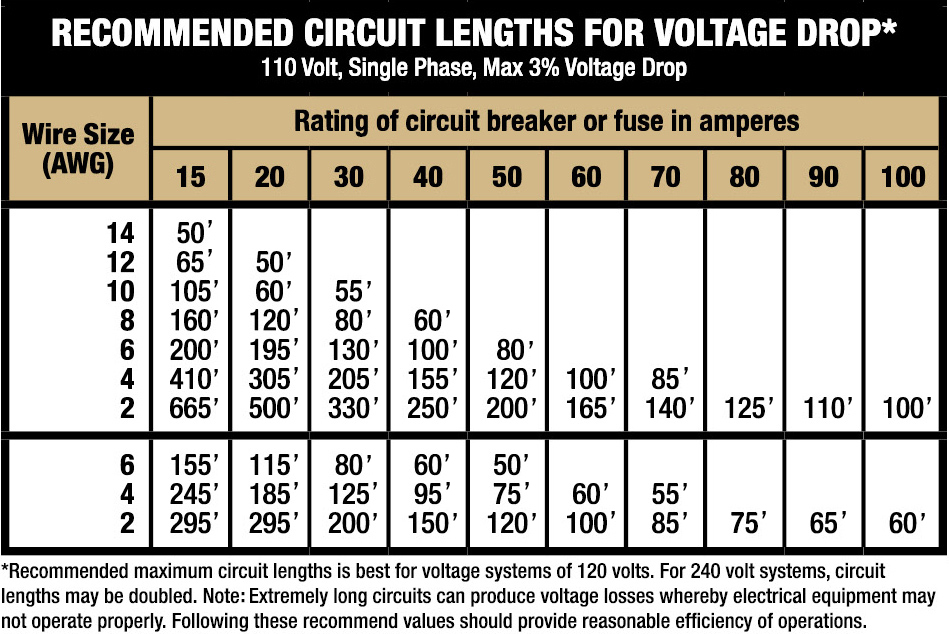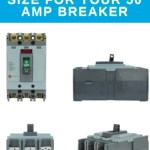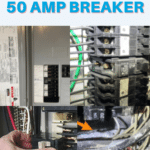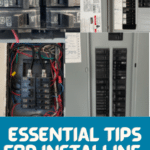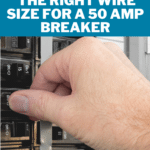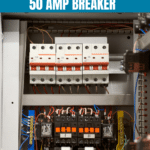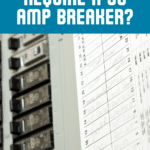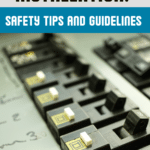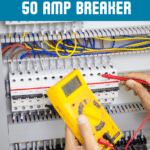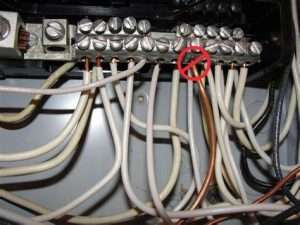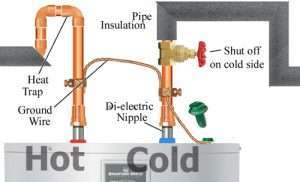Learn What Wire Size For a 50 Amp Breaker (2023 Guide)
If you’re a homeowner or renter, chances are you’ve had to deal with a breaker tripping at some point. It’s always frustrating when it happens, especially if you don’t know what caused it. One of the most common causes of breaker tripping is using the wrong size wire for the breaker. In this blog post, we’ll explain what 50 amp wire size is needed according to the National Electrical Code (NEC). We’ll also provide Some tips on how to avoid making this mistake in the future.
What is a 50 amp breaker and why do you need one in your home?
50 amp breakers are an essential tool in household wiring. If you’re looking to use energy-demanding appliances like hot tubs and air conditioners, 50 amp breakers can provide the current necessary for their operation. 50 amps are higher than what you’d find in most electrical boxes, so having 50 amp capability ensures you haven’t met the requirements of newer, more powerful appliances.
The 50 amp breaker also requires 50 amp wire size – 8 gauge aluminum or 6 gauge copper – ensuring a safe link between the circuit and device regardless of its power needs. I recommend 50amp breakers for safety, performance, and longevity in your home.
A 6-gauge wire conductor is a minimum size required for a 50-amp circuit breaker, as stated in the American Wire Standard (AWS). Using thinner wires results in an electrical system that does not meet code requirements and can pose a serious safety hazard.
Using a wire size that is too small will cause the circuit breaker to trip often. Certain circuits require two-pole breakers, which means you’ll need twice as much 6-gauge conductor for installation. This is because each pole of a two-pole 50 amp breaker requires its own wire.
What is the appropriate 50 Amp wire size for a 50-Amp circuit breaker?
The appropriate 50 amp wire size is 4 gauge aluminum or 6 gauge copper. This meets the requirements of the American Wire Standard (AWS). Using thinner wires will result in an electrical system that does not meet code requirements and can pose a serious safety hazard.
The American Wire Gauge (AWG) system classifies the ratings for wires with a copper conductor core. Some circuits use aluminum core conductor wiring instead, which requires a different 50 amp wire size than if using a 50-amp circuit breaker.
If your circuit uses an aluminum conductor, you need to use at least a 4-gauge wire for compatibility. You can use aluminum where cable weight and cost are factors since the aluminum cable is significantly lighter and cheaper than the copper equivalent. Many older homes use aluminum wiring, but most modern homes use copper core wires which are 61% more efficient for electricity transmission.
WIRE SIZE AMPACITY CHART
The following chart provides information on the appropriate wire gauge to handle the maximum electrical current or amperage. It’s important to note that the wire gauge may differ depending on whether you use copper or aluminum wires. The chart below lists the wire gauge sizes for copper wires, which are more commonly used.
| Maximum Amps | 7 | 10 | 15 | 20 | 30 | 40 | 55 | 70 | 95 |
| Gauge (Wire Size) | 18 | 16 | 14 | 12 | 10 | 8 | 6 | 4 | 2 |
Always check the amp requirements of an appliance before using it, which can be calculated by dividing Watts by Volts.
- 10 AMP WIRE SIZE: A wire gauge of 16 is suitable for a maximum of 10 amps. Appliances that typically require around 10 amps include toasters, hair dryers, vacuum cleaners, radiators, washing machines, dishwashers, and refrigerators.
- 30 AMP WIRE SIZE: A wire gauge of 10 is required for a maximum of 30 amps. A central air conditioner is the most common household item requiring a 30 amp circuit. People living in RVs often use 30 or 50 amp systems to power all the appliances in the vehicle.
- 40 AMP WIRE SIZE: A wire gauge of 8 is necessary for a maximum of 40 amps. Many electric cooking appliances, such as electric cooktops, require 40 amps.
- 50 AMP WIRE SIZE: A wire gauge of 6 is needed for a maximum of 50 amps. Fifty-amp breakers are commonly used for electric ranges, sizeable electric water heaters, and commercial applications.
50 AMP Wire Size and Others Explained
A 50-amp circuit wattage calculated at 240 volts is 12,000 watts. The limit for the maximum wattage on this circuit is 80% of that total number, equaling 9600 watts. To ensure you’re not exceeding the limit, find and check the wattage of each appliance connected to this particular circuit by totaling all Watts. If it’s more than 9600 Watts in appliances connected—it’s too many and you should try removing some till it totals under that amount.
Frequently Asked Questions
What size wire is required for a 50 amp circuit?
The optimum wire size for 50 Amps is 6 AWG; however, the precise size may differ depending on building code, potential voltage drops, material used, duty cycle and ambient temperature. It’s worth noting that I calculated this taking 3% voltage drop into account. The gauge specifies the width of a wire.
What 50 amp wire size to use for 50 amp RV Service?
The size of the wire you will need for a 50 amp RV service is No. 4 AWG. A general rule of thumb is that larger diameter wires come in smaller numbers. For example, No. 2 is bigger than No.4 . It’s important to know that there are different types of aluminum wires before making your purchase as well . The two most common types are THWN and RHW , however if you’re using it for 40 amps, then you’ll need a No. 6 wire .
What 50 amp wire size do I need for 50 amp service wire size?
If you want to install a 50-amp panel and need to know the 50 amp sub panel wire size, you will need at least 8 AWG copper conductors. If you are looking for 60 ampere panel, then 6 AWG copper conductors will be necessary. For a 50 -amp aluminum wire , No. 4 AGW should be sufficient.
What size wire do I need for a 50 amp service 100 feet?
If you run 50 amps to a sub-panel 100 feet away, the appropriate wire size is 4 AWG copper. You should also ensure that the 50 amp breaker in your main panel can handle the current load. An appropriately rated transfer switch is also essential if you’re connecting this wiring to a generator. Finally, ensure all your connections are properly insulated and sealed with wire nuts or electrical tape. This will ensure they remain secure and don’t cause any safety hazards.
Will #8 wire carry 50 amps?
No, 8 AWG wire cannot carry 50 amps safely. 50 Amps requires at least 6 AWG wire. Also, if you’re running 50 Amps to a sub-panel 100 feet away, the appropriate wire size is 4 AWG copper. It’s important to use an appropriately rated transfer switch if you’re connecting this wiring to a generator and make sure that all of your connections are properly insulated and sealed with wire nuts or electrical tape for safety reasons. If in doubt, consult a qualified electrician for help and advice about 50 amp wiring requirements.
What wire do I need for 240v 50 amp?
For a 50 Amp 240V circuit, you will need at least 8 AWG copper conductors. 50 Amp wiring should be larger than other wiring types to safely handle the increased current flow. Ensure all your connections are properly insulated and sealed with wire nuts or electrical tape for safety reasons. Consult a qualified electrician for help and advice about 50 amp wiring requirements when in doubt. Consider duty cycle and ambient temperature when determining 50 amp wire size requirements. It’s also important to check voltage drop when the one-way circuit length exceeds the system voltage number so that you can use the proper 50 amp wire size for your 50 amp circuits.
Can 10 AWG handle 50 amps?
No, 10 AWG wire cannot safely handle 50 amps. For a 50 Amp circuit, you need to use at least 8 AWG copper conductors. It is important to note that 50 amp wiring should be larger than other wiring types to safely handle the increased current flow. Additionally, ensure all your connections are properly insulated and sealed with wire nuts or electrical tape for safety reasons. If you’re unsure about 50 amp wiring requirements, consult a qualified electrician for help and advice. Finally, consider duty cycle and ambient temperature when determining wire size requirements and voltage drop if the one-way circuit length exceeds the system voltage number.
Recommend Lengths For Voltage Drop
As a general rule of thumb, you should check the voltage drop when the one-way circuit length in feet exceeds the system voltage number. For example, if you’re using a 240V system and the circuit length exceeds 240 feet, you’ll need to check for voltage drop. 50 amp wire requirements will depend on your system voltage and how long the one-way circuit length is.
Always use the proper wire for 50 amp circuits to ensure safety, performance, and efficiency. Remember that 50 amp wiring needs to be larger than other wiring types in order to handle the increased current flow. Consult a qualified electrician about the 50 amp wire size and for voltage drop calculations.
Summary: 50 AMP Wire Size
Choosing the correct wire size for a 50-amp breaker is critical to ensuring the safety of your home’s electrical system. A 6-gauge copper conductor is a minimum size required by code, and using anything thinner can pose a severe safety hazard. We hope this guide has helped you understand what wire size you need for a 50-amp breaker.
Reminder: Consult a qualified electrician about the 50 amp wire size and for voltage drop calculations.
If you have any questions, please don’t hesitate to contact us. We would be happy to help clarify anything that may still be unclear.


